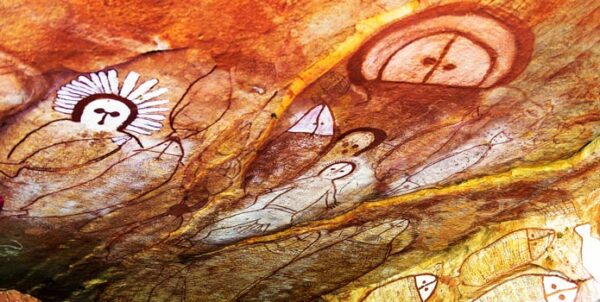In the remote Kimberley region of north-western Australia lies one of humanity’s greatest artistic legacies. The rock art found here, some dating back 41,000 to possibly 50,000 years, represents one of the oldest known human-made artworks on Earth. Created by Indigenous Australians, these ancient masterpieces are more than historical artifacts—they are sacred stories, cultural records, and living connections to the Dreaming.
ALSO READ: Ancient Egyptian Artifact Resembling a Modern Airplane Sparks Controversy
A Timeless Canvas: The Rock Art of the Kimberley
Scattered across sandstone cliffs, rock shelters, and boulders, the Kimberley region is home to tens of thousands of rock art sites. Many remain unexplored, hidden in the rugged terrain. Archaeologists and Indigenous communities continue to discover new sites, each adding more depth to our understanding of ancient human life in Australia.

This extensive body of work includes petroglyphs (rock carvings) and pictographs (rock paintings) made using natural materials. Artists used ochre pigments, charcoal, beeswax, resins, and even scraped earth to create stunning visual compositions that have endured for tens of thousands of years.
Gwion Gwion: The Elegant Ancestors
One of the most intriguing styles of Kimberley rock art is the Gwion Gwion (formerly called Bradshaw) paintings. These figures are slim, dynamic, and highly detailed—often depicted in ceremonial poses, adorned with tassels, headgear, and body decorations. Their refined lines and animated stances suggest a sophisticated culture deeply immersed in ceremony, dance, and symbolism.
Some researchers suggest the Gwion Gwion figures could be over 17,000 years old, though some Indigenous accounts hint they may be even older. The true age remains debated, but their artistic complexity is universally acknowledged.

Wandjina: The Powerful Rain Spirits
In stark contrast to the fine lines of Gwion Gwion figures are the Wandjina spirits—ancestral beings associated with creation, rain, and fertility. These figures are characterized by large, round faces, huge eyes, no mouths, and radiant head halos. Believed by the Wunambal, Ngarinyin, and Worrorra peoples to be living beings, the Wandjina are still repainted today by Indigenous custodians as part of ongoing cultural practices.
These figures are not merely decorative; they are sacred. To speak their names or alter their images without permission is considered deeply disrespectful. The continued reverence for the Wandjina highlights the living connection between the past and present in Aboriginal culture.
Techniques and Materials: How Ancient Art Survived
Kimberley artists employed a range of techniques to create their rock art. They used:
-
Ochre pigments mixed with water, blood, or fat
-
Beeswax and plant resins for texture and binding
-
Scraped rock surfaces to reveal lighter colors beneath charred surfaces
-
Stone arrangements to mark sacred sites or stories

The durability of Kimberley rock art is due in part to the chemical bond between ochre and sandstone, as well as the remoteness of the locations, which protected them from vandalism and erosion.
Preserving the Past: Collaboration Between Indigenous Rangers and Archaeologists
The preservation of Kimberley rock art is a joint effort. Indigenous Rangers, trained in land and heritage management, work closely with archaeologists to protect and monitor these sacred sites. Together, they map locations, document threats, and educate the public on the cultural and spiritual significance of the art.
Organizations such as the Kimberley Foundation and Aboriginal corporations have also played a crucial role in funding research, promoting awareness, and involving local communities in conservation efforts.

A Living Legacy
Kimberley rock art is not just an archaeological treasure; it is a living tradition. For the Indigenous people of Australia, these artworks are not relics. They still infuse the sacred landscape with meaning, memory, and spiritual energy. As modern science works to date and analyze the art, it is Indigenous knowledge that truly brings it to life.
By protecting these ancient artworks. We not only preserve human history—we honor the world’s oldest continuous culture and its enduring relationship with the land.


